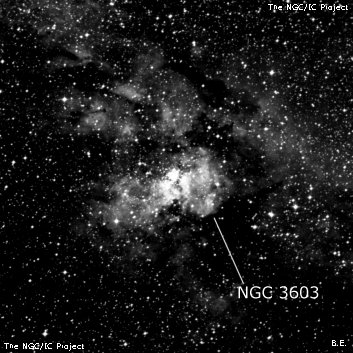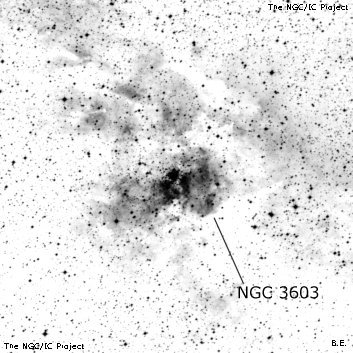NGC/IC Project Restoration Effort
(This is a very very beta version)
NGC3603


Basic Information
Location and Magnitude
Right Ascension: 11:15:6.6
Declination: -61:15:40
Constellation: CAR
Visual Magnitude: 9.1
Historic Information
Discoverer: Herschel J.
Year of discovery: 1834
Discovery aperture: 18.3
Observational
Summary description: globular and neb, st 15…18
Sub-type: I1pn
Steve's Notes
=====
NGC 3603
24" (4/5/08 - Magellan Observatory, Australia): this distant (20,000 light years) superluminous HII region and cluster was mesmerizing at 200x using a UHC filter. The nebulosity is generally elongated E-W, ~5'x3', but with bays and extensions and dark lanes. The surface brightness is highest to the south of the embedded cluster with a dark lane slashing through the nebulosity just west of the bright core. At 350x, 15-20 stars were resolved in the glow, though the tiny, brilliant "core" cluster (HD 97950) was only mottled and barely resolved into a few stars.
13.1" (2/20/04 - Costa Rica): at 105x a bright irregular nebula surrounds a mag 9 "star". At 200x, a half-dozen very faint stars are packed very close to the central star. This very compact knot is actually a distant, very dense, young cluster of extremely luminous stars! Adding a UHC filter, the nebulosity is irregular at 105x, extending mostly south of the star and fading out into two or three sections that are possibly divided by a dark lane. The brightest section is to the southwest of the central star.
18" (7/7/02 - Magellan Observatory, Australia): at 228x this distant but superluminous HII region is a fascinating clump of stars of and nebulosity surrounding a bright 9th magnitude knot. The bright central region was extremely dense and contained 10-12 stars crammed into 2', yet it seemed only partially resolved at the very center into a couple of stars. At 128x and UHC filter, the surrounding "haze" is clearly gaseous in nature with the brightest portion offset to the SW side from the core with a roughly broad fan with a total size of approximately 5'x3'. A dark lane appears to cut through the nebulosity towards the core and there is a strong impression that the field is riddled with dust lanes and patches. This is a well-studied highly reddened, luminous cluster (~20,000 light years) and HII region with similarities to the Tarantula nebula in the LMC!



